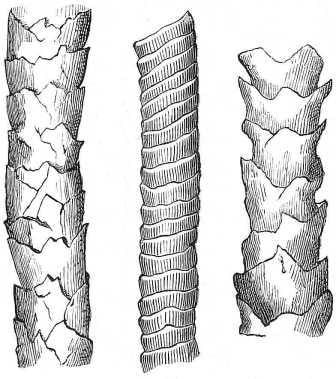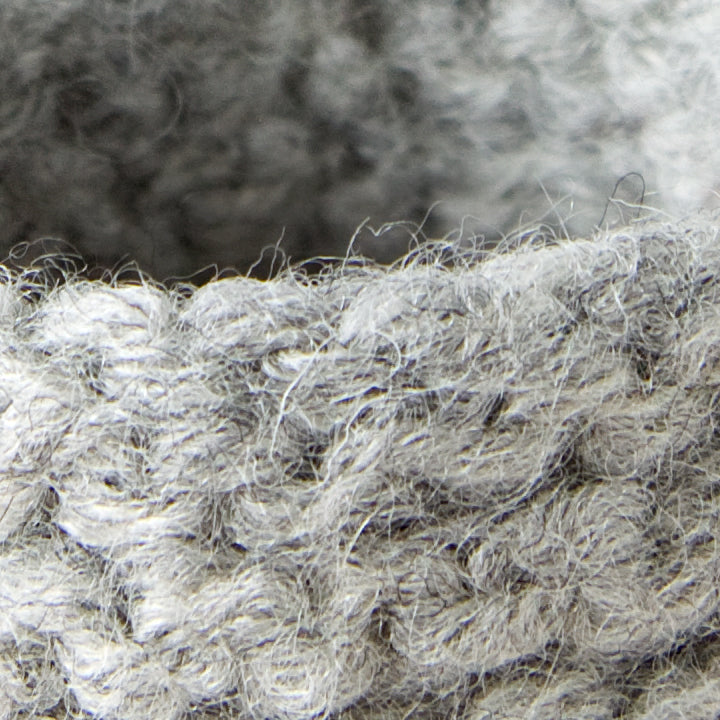Wool, and most other mammal fibers, tends to mat together when it gets wet or agitated. This tendency can be frustrating (see accidental sweater felting, above) or fantastic. Here in Canada, when I was a child, a lot of our history lessons had to do with the Hudson's Bay Company and the fur trade. Kids my age could rattle off by rote that the fur trade was key to economic expansion of the HBC because felted hats were fashionable at the time. But for many years I couldn't picture how beavers got turned into hats. The answer, of course, is in the felting.
What is felting?
Felting bonds and compresses animal fiber to make a dense, flat, warm fabric, using heat, moisture and agitation (and in some industries, chemicals such as acid). Felt can be shaped, made thicker, cut, and sewn. It lasts for a long time, resists water absorption, and is incredibly versatile.
Scales! Who's got them?
Most mammal fibers like sheep wool and human hair are fine strands with a solid core and a scaly surface. The scales are invisible to the naked eye. These scales point away from the root of the fiber. Try this cool experiment: pluck out one of your hairs (ouch) and rub it back and forth between finger and thumb. No matter which direction the hair is pointing, your thumb and finger will "walk" away from the root towards the tip of the hair. That's because you're using the microscopic scales, which point towards the tip, like steps! Ever back combed your hair? You rapidly comb the hair back towards the root, roughing up the scales; add a little hair-spray, and the now-roughened hair sticks together. Not only will you look like Emma Peel circa 1965, but you will have demonstrated the scaliness of mammalian hair.
These scales are also what makes mammal hair dye-absorbent.
 Here's a nice little illustration from a 1906 article presented by Watson Smith to the Hat Manufacturers' Association. It shows "Finest merino wool fibre. Typical wool fibre. Fibre of wool from Chinese sheep."
Here's a nice little illustration from a 1906 article presented by Watson Smith to the Hat Manufacturers' Association. It shows "Finest merino wool fibre. Typical wool fibre. Fibre of wool from Chinese sheep."So if mammal hair is scaly, why doesn't my dog's fur felt when I give him a shampoo?
When the Olde Timey folks were making hats out of animal hair, they treated it first, usually with some kind of acid. (This is why the Mad Hatter is mad; mercury poisoning from the nitric acid from nitrate of mercury. Grim eh?) The acid etched the surface and roughened the scales. Only some mammal hair is naturally scaly enough to felt without a lot of work or a chemical additive.
The scales on wool, and other animal fibers like alpaca and cashmere, are naturally long and pointy, and can even resemble thorns. These thorny scales, when at rest, lie fairly close to the surface. When wool is agitated, or wet, the scales flare out from the surface. This quality is what makes wool warm even when wet; a wool sweater in the rain tends to get a little fluffier, and can absorb water without feeling wet. Compare it to a cotton sweater, which absorbs water and gets smoother and flatter, with more space between the strands. This is because cotton fiber is smooth and relatively flat, spiraling to make a semi-hollow core. Great for towels but not for standing on the moor in a cold drizzle.
It's also interesting that only fiber from a healthy animal has these properties. A sick sheep will have degraded or badly formed fleece, that will resist felting and dyeing.
How to felt wool
The ingredients: agitation, moisture, heat. The more of these ingredients you use, the better.
Start with feltable fiber. Wool works really well, other animal fibers like mohair and alpaca can be feltable. Try a swatch first before embarking on a big project. Some fibers are too slippery to felt easily. Others have been treated to resist felting or colour absorption. Watch out for "superwash," "washable," or white yarns.
If knitting before felting, try using larger needles than usual. I've found that any wool item will felt eventually, but a looser knit does seem to be more successful.
Anything you felt will shrink, so account for that in your planning.
Needle felting
Uses Agitation. Start with clean, carded, unspun fleece (roving), and stab repeatedly. Okay, it's not quite that simple. You must stab it with a felting needle. A felting needle has a hooked surface that teases out the scales on the wool so that they hook on to each other. Basically extreme back combing.
Spit grafting
Uses Moisture + Agitation. When you join a new ball of (feltable) wool to your knitting, you can spit-graft or felt-graft the end of the old ball to the beginning of the new ball. Fray both ends slightly, moisten your palm (yes, that's where the "spit" comes into it, but you can use water), overlap the ends in your palm, and then put your hands together and quickly and firmly roll the ends together.
Hand felting
Uses Moisture + Heat + Agitation. Fun and easy, but time consuming. Gives you lots of control over the process, unlike machine felting (see below). Protect your work surface, there will be splashing. Fill a container, much larger than your project, with hot water and a little bit of dish soap. Add knitted item. Agitate with your hands if you like, but it might (should) be too hot. I use a potato masher and mash the thing just like potatoes. Continue agitating. Then follow the agitation with a bout of agitation. Repeat. Gently lift the item out and check it for felting. (When it starts to felt, the stitches will start to look like they're sticking to each other.) It won't be ready, so put it back in and continue agitating. Depending on the fiber, the size of the project, and your elbow grease, it can take anywhere from 5-45 minutes for something to felt.
You can encourage the felting by dunking the item into cold water and gently pressing out the water. The expanded fiber will contract a bit in the cold, and hold on tighter when you press it together.
When it's as felted as you want, roll it up in a clean towel and press the excess water out.
Machine felting
Uses Moisture + Heat + Agitation. The least labour-intensive way to felt, and sometimes, the best. Set your washing machine to the hottest cycle. Put the knitted item to be felted in a laundry bag or pillow case. This makes it easier to find and also protects your washer from excess fibers going into the rinse, and thus into your washer's filter. Add the item, in its bag, to a load of laundry. I put it in there with anything, but avoid fluffy items; any fluff (like from towels) might get trapped in the felted surface.
If you can, check on the item frequently. (My front loading washer door locks at several points in the cycle, so I can't check on the felting very often.) And if you can, take it out before the spin cycle. Although the spin cycle squeezes out the water and helps the felting, it also wads everything up, and can make creases in your felted item.
A note about HE (high efficiency) front loading washers: Some people have mixed results with these washers. Everyone's washer is different, and the fiber you're using plays a big role in felting, but try this: set the cycle to the highest agitation (set the soil setting to high), add something heavy like jeans to the load, and if it doesn't felt the first time, run it through twice. And if that doesn't work, and you're sure the item is indeed feltable (watch out for superwash and white, see above) then try hand felting. Also, if you do a lot of felting in your front-loading washing machine, don't forget to clean out the pump filter (gross). It's usually at the front, under the door, but check your manual.
But now it's just a wet blob of wool
 Ah ha, the icing on this cake is in the blocking. Yes, you've got a damp blob of sheep-smelling blob. But, you are the master of that blob. Pull it, push it, pin it, mold it over something, and let it dry. It will hold that shape. Felting a bowl? Block it over a bowl. A tam? Block it over a plate.
Ah ha, the icing on this cake is in the blocking. Yes, you've got a damp blob of sheep-smelling blob. But, you are the master of that blob. Pull it, push it, pin it, mold it over something, and let it dry. It will hold that shape. Felting a bowl? Block it over a bowl. A tam? Block it over a plate.Have a felting story to share? Leave a comment below!
